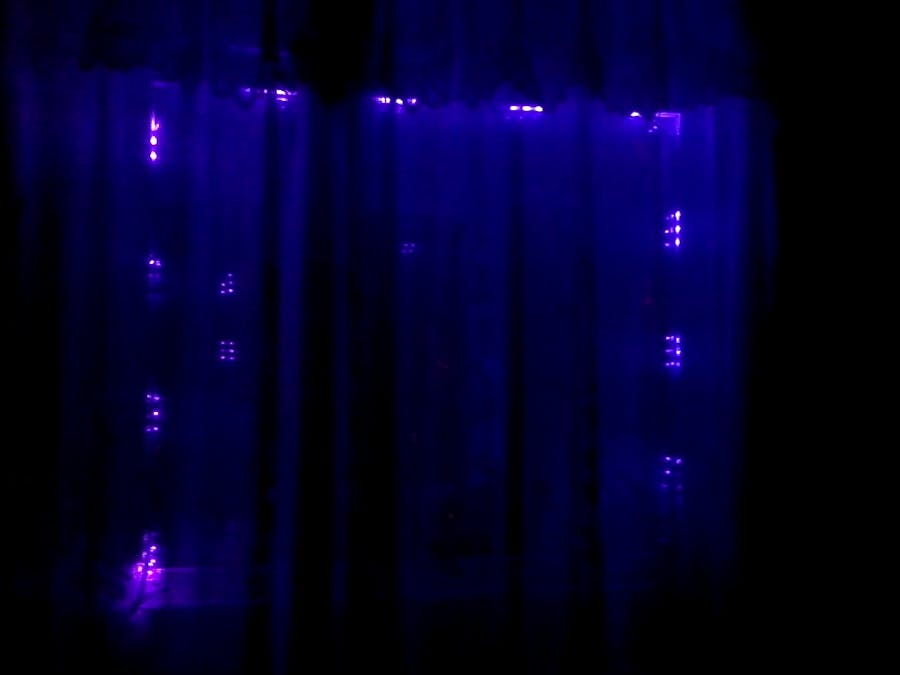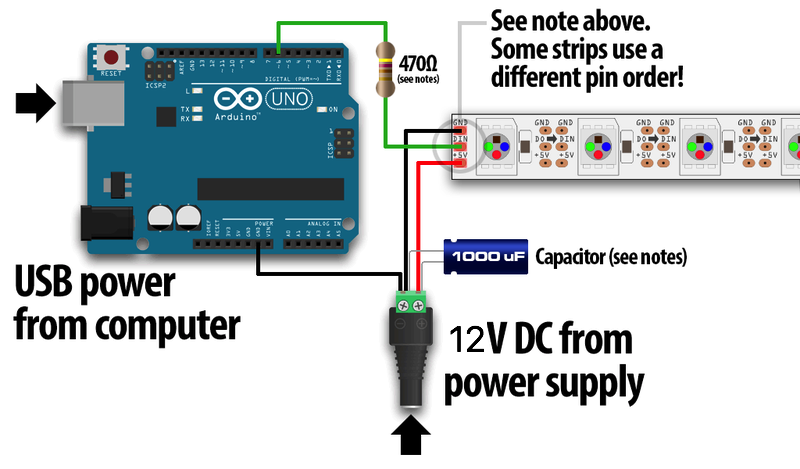Hardware components | ||||||
| × | 1 | ||||
 |
| × | 1 | |||
 |
| × | 1 | |||
Here's my Arduino light show based on WS2811 RGB led strip. The
These leds require 12v so it was simple to get a power supply that can drive all of them. The rule is a led requires 60mA.
The led strip can be controlled with as low as 3.3v on the Digital pin, so it's Arduino mkr1000 safe (as well as Raspberry Pi, ESP8266,..) since MKR board has Doutput of 3.3v.
Here are some great tips in designing a led strip project:
https://learn.adafruit.com/adafruit-neopixel-uberguide/best-practices
#include <Adafruit_NeoPixel.h>
// SETUP YOUR OUTPUT PIN AND NUMBER OF PIXELS
#define PIN 4
#define NUM_PIXELS 99
#define BRIGHTNESS 200
Adafruit_NeoPixel strip = Adafruit_NeoPixel(NUM_PIXELS, PIN, NEO_GRB + NEO_KHZ800);
int gamma[] = {
0, 0, 0, 0, 0, 0, 0, 0, 0, 0, 0, 0, 0, 0, 0, 0,
0, 0, 0, 0, 0, 0, 0, 0, 0, 0, 0, 0, 1, 1, 1, 1,
1, 1, 1, 1, 1, 1, 1, 1, 1, 2, 2, 2, 2, 2, 2, 2,
2, 3, 3, 3, 3, 3, 3, 3, 4, 4, 4, 4, 4, 5, 5, 5,
5, 6, 6, 6, 6, 7, 7, 7, 7, 8, 8, 8, 9, 9, 9, 10,
10, 10, 11, 11, 11, 12, 12, 13, 13, 13, 14, 14, 15, 15, 16, 16,
17, 17, 18, 18, 19, 19, 20, 20, 21, 21, 22, 22, 23, 24, 24, 25,
25, 26, 27, 27, 28, 29, 29, 30, 31, 32, 32, 33, 34, 35, 35, 36,
37, 38, 39, 39, 40, 41, 42, 43, 44, 45, 46, 47, 48, 49, 50, 50,
51, 52, 54, 55, 56, 57, 58, 59, 60, 61, 62, 63, 64, 66, 67, 68,
69, 70, 72, 73, 74, 75, 77, 78, 79, 81, 82, 83, 85, 86, 87, 89,
90, 92, 93, 95, 96, 98, 99,101,102,104,105,107,109,110,112,114,
115,117,119,120,122,124,126,127,129,131,133,135,137,138,140,142,
144,146,148,150,152,154,156,158,160,162,164,167,169,171,173,175,
177,180,182,184,186,189,191,193,196,198,200,203,205,208,210,213,
215,218,220,223,225,228,231,233,236,239,241,244,247,249,252,255 };
void setup() {
strip.setBrightness(BRIGHTNESS);
strip.begin();
clearStrip(); // Initialize all pixels to 'off'
delay(1000);
}
void loop() {
knightRider(2, 50, 4, 0xFF1000); // Cycles, Speed, Width, RGB Color (original orange-red)
colorWipe(strip.Color(255, 0, 0), 50); // Red
knightRider(2, 50, 3, 0xFF00FF); // Cycles, Speed, Width, RGB Color (purple)
colorWipe(strip.Color(0, 0, 255), 50); // Blue
knightRider(2, 50, 2, 0x0000FF); // Cycles, Speed, Width, RGB Color (blue)
colorWipe(strip.Color(0, 0, 255), 50); // Blue
knightRider(2, 50, 5, 0xFF0000); // Cycles, Speed, Width, RGB Color (red)
colorWipe(strip.Color(255, 0, 0), 50); // Red
knightRider(2, 50, 6, 0x00FF00); // Cycles, Speed, Width, RGB Color (green)
colorWipe(strip.Color(0, 255, 0), 50); // Green
knightRider(2, 50, 7, 0xFFFF00); // Cycles, Speed, Width, RGB Color (yellow)
colorWipe(strip.Color(0, 0, 0, 255), 50); // yellow
knightRider(2, 50, 8, 0x00FFFF); // Cycles, Speed, Width, RGB Color (cyan)
colorWipe(strip.Color(0, 0, 0, 255), 50); // Cyan
knightRider(2, 50, 2, 0xFFFFFF); // Cycles, Speed, Width, RGB Color (white)
colorWipe(strip.Color(0, 0, 0, 255), 50); // White
whiteOverRainbow(20,75,5);
pulseWhite(5);
rainbowFade2White(3,3,1);
clearStrip();
delay(500);
}
// Cycles - one cycle is scanning through all pixels left then right (or right then left)
// Speed - how fast one cycle is (32 with 16 pixels is default KnightRider speed)
// Width - how wide the trail effect is on the fading out LEDs. The original display used
// light bulbs, so they have a persistance when turning off. This creates a trail.
// Effective range is 2 - 8, 4 is default for 16 pixels. Play with this.
// Color - 32-bit packed RGB color value. All pixels will be this color.
// knightRider(cycles, speed, width, color);
void knightRider(uint16_t cycles, uint16_t speed, uint8_t width, uint32_t color) {
uint32_t old_val[NUM_PIXELS]; // up to 256 lights!
// Larson time baby!
for(int i = 0; i < cycles; i++){
for (int count = 1; count<NUM_PIXELS; count++) {
strip.setPixelColor(count, color);
old_val[count] = color;
for(int x = count; x>0; x--) {
old_val[x-1] = dimColor(old_val[x-1], width);
strip.setPixelColor(x-1, old_val[x-1]);
}
strip.show();
delay(speed);
}
for (int count = NUM_PIXELS-1; count>=0; count--) {
strip.setPixelColor(count, color);
old_val[count] = color;
for(int x = count; x<=NUM_PIXELS ;x++) {
old_val[x-1] = dimColor(old_val[x-1], width);
strip.setPixelColor(x+1, old_val[x+1]);
}
strip.show();
delay(speed);
}
}
}
void clearStrip() {
for( int i = 0; i<NUM_PIXELS; i++){
strip.setPixelColor(i, 0x000000); strip.show();
}
}
uint32_t dimColor(uint32_t color, uint8_t width) {
return (((color&0xFF0000)/width)&0xFF0000) + (((color&0x00FF00)/width)&0x00FF00) + (((color&0x0000FF)/width)&0x0000FF);
}
// Using a counter and for() loop, input a value 0 to 251 to get a color value.
// The colors transition like: red - org - ylw - grn - cyn - blue - vio - mag - back to red.
// Entering 255 will give you white, if you need it.
uint32_t colorWheel(byte WheelPos) {
byte state = WheelPos / 21;
switch(state) {
case 0: return strip.Color(255, 0, 255 - ((((WheelPos % 21) + 1) * 6) + 127)); break;
case 1: return strip.Color(255, ((WheelPos % 21) + 1) * 6, 0); break;
case 2: return strip.Color(255, (((WheelPos % 21) + 1) * 6) + 127, 0); break;
case 3: return strip.Color(255 - (((WheelPos % 21) + 1) * 6), 255, 0); break;
case 4: return strip.Color(255 - (((WheelPos % 21) + 1) * 6) + 127, 255, 0); break;
case 5: return strip.Color(0, 255, ((WheelPos % 21) + 1) * 6); break;
case 6: return strip.Color(0, 255, (((WheelPos % 21) + 1) * 6) + 127); break;
case 7: return strip.Color(0, 255 - (((WheelPos % 21) + 1) * 6), 255); break;
case 8: return strip.Color(0, 255 - ((((WheelPos % 21) + 1) * 6) + 127), 255); break;
case 9: return strip.Color(((WheelPos % 21) + 1) * 6, 0, 255); break;
case 10: return strip.Color((((WheelPos % 21) + 1) * 6) + 127, 0, 255); break;
case 11: return strip.Color(255, 0, 255 - (((WheelPos % 21) + 1) * 6)); break;
default: return strip.Color(0, 0, 0); break;
}
}
// Fill the dots one after the other with a color
void colorWipe(uint32_t c, uint8_t wait) {
for(uint16_t i=0; i<strip.numPixels(); i++) {
strip.setPixelColor(i, c);
strip.show();
delay(wait);
}
}
void pulseWhite(uint8_t wait) {
for(int j = 0; j < 256 ; j++){
for(uint16_t i=0; i<strip.numPixels(); i++) {
strip.setPixelColor(i, strip.Color(0,0,0, gamma[j] ) );
}
delay(wait);
strip.show();
}
for(int j = 255; j >= 0 ; j--){
for(uint16_t i=0; i<strip.numPixels(); i++) {
strip.setPixelColor(i, strip.Color(0,0,0, gamma[j] ) );
}
delay(wait);
strip.show();
}
}
void rainbowFade2White(uint8_t wait, int rainbowLoops, int whiteLoops) {
float fadeMax = 100.0;
int fadeVal = 0;
uint32_t wheelVal;
int redVal, greenVal, blueVal;
for(int k = 0 ; k < rainbowLoops ; k ++){
for(int j=0; j<256; j++) { // 5 cycles of all colors on wheel
for(int i=0; i< strip.numPixels(); i++) {
wheelVal = Wheel(((i * 256 / strip.numPixels()) + j) & 255);
redVal = red(wheelVal) * float(fadeVal/fadeMax);
greenVal = green(wheelVal) * float(fadeVal/fadeMax);
blueVal = blue(wheelVal) * float(fadeVal/fadeMax);
strip.setPixelColor( i, strip.Color( redVal, greenVal, blueVal ) );
}
//First loop, fade in!
if(k == 0 && fadeVal < fadeMax-1) {
fadeVal++;
}
//Last loop, fade out!
else if(k == rainbowLoops - 1 && j > 255 - fadeMax ){
fadeVal--;
}
strip.show();
delay(wait);
}
}
delay(500);
for(int k = 0 ; k < whiteLoops ; k ++){
for(int j = 0; j < 256 ; j++){
for(uint16_t i=0; i < strip.numPixels(); i++) {
strip.setPixelColor(i, strip.Color(0,0,0, gamma[j] ) );
}
strip.show();
}
delay(2000);
for(int j = 255; j >= 0 ; j--){
for(uint16_t i=0; i < strip.numPixels(); i++) {
strip.setPixelColor(i, strip.Color(0,0,0, gamma[j] ) );
}
strip.show();
}
}
delay(500);
}
void whiteOverRainbow(uint8_t wait, uint8_t whiteSpeed, uint8_t whiteLength ) {
if(whiteLength >= strip.numPixels()) whiteLength = strip.numPixels() - 1;
int head = whiteLength - 1;
int tail = 0;
int loops = 3;
int loopNum = 0;
static unsigned long lastTime = 0;
while(true){
for(int j=0; j<256; j++) {
for(uint16_t i=0; i<strip.numPixels(); i++) {
if((i >= tail && i <= head) || (tail > head && i >= tail) || (tail > head && i <= head) ){
strip.setPixelColor(i, strip.Color(0,0,0, 255 ) );
}
else{
strip.setPixelColor(i, Wheel(((i * 256 / strip.numPixels()) + j) & 255));
}
}
if(millis() - lastTime > whiteSpeed) {
head++;
tail++;
if(head == strip.numPixels()){
loopNum++;
}
lastTime = millis();
}
if(loopNum == loops) return;
head%=strip.numPixels();
tail%=strip.numPixels();
strip.show();
delay(wait);
}
}
}
void fullWhite() {
for(uint16_t i=0; i<strip.numPixels(); i++) {
strip.setPixelColor(i, strip.Color(0,0,0, 255 ) );
}
strip.show();
}
// Slightly different, this makes the rainbow equally distributed throughout
void rainbowCycle(uint8_t wait) {
uint16_t i, j;
for(j=0; j<256 * 5; j++) { // 5 cycles of all colors on wheel
for(i=0; i< strip.numPixels(); i++) {
strip.setPixelColor(i, Wheel(((i * 256 / strip.numPixels()) + j) & 255));
}
strip.show();
delay(wait);
}
}
void rainbow(uint8_t wait) {
uint16_t i, j;
for(j=0; j<256; j++) {
for(i=0; i<strip.numPixels(); i++) {
strip.setPixelColor(i, Wheel((i+j) & 255));
}
strip.show();
delay(wait);
}
}
// Input a value 0 to 255 to get a color value.
// The colours are a transition r - g - b - back to r.
uint32_t Wheel(byte WheelPos) {
WheelPos = 255 - WheelPos;
if(WheelPos < 85) {
return strip.Color(255 - WheelPos * 3, 0, WheelPos * 3,0);
}
if(WheelPos < 170) {
WheelPos -= 85;
return strip.Color(0, WheelPos * 3, 255 - WheelPos * 3,0);
}
WheelPos -= 170;
return strip.Color(WheelPos * 3, 255 - WheelPos * 3, 0,0);
}
uint8_t red(uint32_t c) {
return (c >> 8);
}
uint8_t green(uint32_t c) {
return (c >> 16);
}
uint8_t blue(uint32_t c) {
return (c);
}
4 projects • 26 followers
Electronic engineer and hobbyist, during my life I have worked with all known embedded motherboards and shields. I'm looking to improve life with great ideas.




Comments